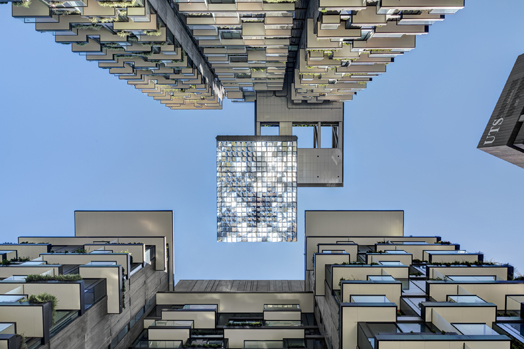Compiled by Pari Syal
Photography: Murray Fredericks;
courtesy Frasers Property Australia and Sekisui House Australia
Moving
ahead of Australian Green Star compliance, One Central Park (OCP) by Ar. Jean
Nouvel is an innovative and environmentally ambitious landmark project that takes
a broader approach to carbon conscious design and exceeds the highest standards
of sustainable residential design.
As
the iconic centerpiece of the redevelopment of the Carlton & United Brewery
site in Sydney, OCP uses two unusual technologies - hydroponics and heliostats:
plants are grown all around the building to provide organic shading, and direct
sunlight is harvested all year long for heating and lighting. The shading saves
cooling energy, while the redirected sunlight is an all-year light source for
the building precinct and adjoining park. Beyond the bravado of their technical
deployment and performance, the plants and reflected daylight are also just
natural resources, made available in an unusual way for the enjoyment of
Sydney's residents.
The
first design challenge is to give this pivotal new park a real presence at an
urban scale. Because OCP is a high rise, it is possible to bring the park up
into the sky along its facades and make it visible in the city at a distance. So,
a sequence of planted plateaus are scattered like puzzle pieces in randomized
patterns on the South façade, so that each apartment has not only a balcony,
but also its own piece of the park.
.jpg) |
| . |
On
the North, East and West sides, the green takes more continuous veil-like
appearances with green walls, continuous planter bands and climbing vegetation.
The plants deliver a message of sustainability, and because their shade reduces
energy consumption for cooling and their leaves trap carbon dioxide, they also
effectively make the building more sustainable. At the individual scale, this
creates pleasant private gardens and at a collective scale, a green urban
sculpture.
The
second design challenge arises from the tall massing along the North side of
the site. In order to remediate overshadowing of the park, the volume is broken
up into a lower and a taller tower. On the roof of the lower tower, 42
heliostats (sunlight tracking mirrors) redirect sunlight up to 320 reflectors
on a cantilever off the taller tower, which then beam the light down into areas
that would otherwise be in permanent shade. The system adapts hourly and
seasonally to the need for brightness and warmth, so that the dappled lights
move on the ground in a precisely programmed choreography. At night, the
heliostat becomes a monumental urban chandelier and appears in the dark sky
like a floating pool of tiny LED lights that merge into a giant screen and
simulate reflections of glittering harbour waters.
.jpg) |
| . |
OCP is instrumental in harnessing sustainable
strategies by improving the usually poor energy
performance of residential high rises to meet a rating of at least five under
the Australian Green Star standards and achieve a 25% reduction in energy
consumption compared to the average. It also improves energy performance with a
system of 5km long linear slab edge planters that function like permanent
shading shelves and reduce thermal impact in the apartments by up to 30%. The
plants also trap Carbon Dioxide, emit Oxygen and reflect less heat back into
the city than traditional fixed shading. The plants are irrigated with recycled
grey and black water, and their growth can be custom tailored to the needs of
each façade area. During the intermediate seasons, the 2m large glass sliding
doors can be fully opened to benefit from the full impact of direct solar heat.
One Central Park is the recipient of the Best Sustainable Development of the Year
& Overall Winner - Leaf Awards.


.jpg)
.jpg)
.jpg)
.jpg)
Great article Savitha. Thank you!
ReplyDelete